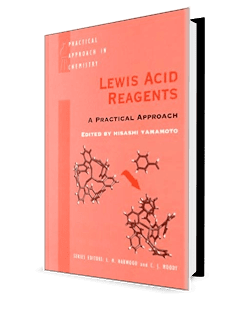| Book Name: | [PDF] Lewis Acid Reagents A Practical Approach |
| Category: | Physical Chemistry |
| Free Download: | Available |
Lewis Acid Reagents A Practical Approach

Book Description:
Lewis acid reagents: a practical approach
Author(s): Hisashi Yamamoto
Publisher: Oxford University Press, Year: 1999
ISBN: 0198500998
[PDF] Lewis Acid Reagents A Practical Approach Table Of Contents
Front Matter……Page 1
List of Contributors……Page 6
Preface……Page 5
Table of Contents……Page 8
1. Introduction……Page 13
2.1 Introduction……Page 17
2.2.1 Amphiphilic Carbonyl Alkylations……Page 18
2.2.2 Amphiphilic Conjugate Alkylations……Page 22
2.2.3 Amphiphilic Conjugate Allylations……Page 24
2.3 Regio- and Stereocontrolled Diels-Alder Reaction……Page 27
2.4 Asymmetric Hetero-Diels-Alder Reaction……Page 28
2.5 Claisen Rearrangement……Page 33
2.6 Epoxide Rearrangement……Page 35
References……Page 40
3.1 Introduction……Page 42
3.2.1 Tris(Pentafluorophenyl)Boron as an Efficient, Air Stable, and Water-Tolerant Lewis Acid Catalyst……Page 43
3.2.2 Diarylborinic Acids as Efficient Catalysts for Selective Dehydration of Aldols……Page 46
3.2.3 3,4,5-Trifluorophenylboronic Acid as an Amidation Catalyst……Page 48
3.3.1 Catalytic Enantioselective Carbo-Diels-Alder Reactions……Page 50
3.3.2 Catalytic Enantioselective Aldol and Allylation Reactions……Page 62
3.3.3 Asymmetric Reactions of Imines Mediated by Chiral Boron Reagents……Page 68
References……Page 72
4.2 Cycloaddition Reactions……Page 75
4.3 Aldol Additions, Allylations, and Other Reactions……Page 81
References……Page 84
5.2 Scope and Limitations……Page 86
References……Page 97
6.1 Introduction……Page 101
6.2 Carbonyl Addition Reaction……Page 104
6.3 Carbonyl-Ene Reaction……Page 109
6.4 Asymmetric Catalytic Desymmetrization……Page 113
6.5 Kinetic Optical Resolution……Page 114
6.6 Positive Non-Linear Effect of Non-Racemic Catalysts……Page 115
6.7 Enantiomer-Selective Activation of Racemic Catalysts……Page 116
6.8 Ene Cyclization……Page 119
6.9 Aldol Reaction……Page 121
6.10 (Hetero) Diels-Alder Reaction……Page 126
6.11 Cyanohydrine Formation……Page 137
6.12 Miscellaneous Reactions……Page 138
References……Page 139
7.1 Introduction……Page 145
7.2.2 Asymmetric Aldol Reactions of Silyl Enol Ethers Derived from Acetic and Propionic Acid Derivatives……Page 146
7.2.3 Asymmetric Synthesis of 2-Substituted Malate Derivatives……Page 148
7.2.4 Asymmetric Synthesis of Syn- and Anti-1,2 Diol Derivatives……Page 151
7.2.5 Catalytic Asymmetric Aldol Reactions……Page 155
7.3 Asymmetric Cyanation Reaction……Page 159
7.4 Asymmetric Protonation……Page 161
References……Page 163
8.1 Introduction……Page 166
8.2 Carbon-Oxygen and Carbon-Nitrogen Bond Formation……Page 167
8.3 Carbon-Carbon Bond Formation……Page 168
8.4 Carbon-Hydrogen Bond Formation……Page 171
References……Page 174
9.2 Enantioselective Aldol Reactions of Activated Isocyanides and Aldehydes……Page 176
9.3 Enantioselective Aldehyde Allylation with Allyltin Reagents Catalysed by a Silver(I)-Phosphine Complex……Page 180
References……Page 182
10.2 Activation of C-F Bond……Page 184
10.3 Activation of Ethers……Page 186
10.4 Carbonyl Activation……Page 187
10.5 Reductive Coupling of Allenes and Alkynes……Page 189
References……Page 191
11.2.1 Friedel-Crafts Reaction……Page 192
11.2.2 Acetalization……Page 196
11.2.3 Acetylation and Esterification of Alcohol……Page 197
11.2.4 Allylation of Carbonyl Compounds with Tetra-Allyltin Catalysed by Scandium(III) Triflate……Page 199
11.2.5 Scandium(III) Triflate-Catalysed Mukaiyama Aldol Reaction……Page 201
11.2.6 Diels-Alder Reaction……Page 203
11.3 Cyclopentadienyl Yttrium Hydride……Page 206
References……Page 207
12.2 Cerium(III) Reagents……Page 209
12.3 Europium(III) Reagents……Page 214
12.4 Ytterbium(III) Reagents……Page 220
12.5 Lanthanum(III) Reagents……Page 223
12.6 Other Lanthanide(III) Reagents……Page 225
References……Page 227
13.2 Activation of Haloalkanes and Carbonyl Compounds……Page 230
13.3.1 Achiral Transition-Metal Catalysts……Page 233
13.3.2 Chiral Transition-Metal Catalysts……Page 234
13.4 Asymmetric Aldol Condensations……Page 243
References……Page 247
14.1 Introduction……Page 249
14.2 Principle, Scope, and Limitations of ‘Lewis Acid-Assisted High-Speed Living Anionic Polymerization’……Page 251
References……Page 264









![[PDF] Draw Buildings and Cities in 15 Minutes Draw Buildings and Cities in 15 Minutes pdf](https://www.freepdfbook.com/wp-content/uploads/2021/06/Draw-Buildings-and-Cities-in-15-Minutes-218x150.jpg)








![[PDF] Digital Image Processing An Algorithmic Introduction Using Java Digital Image Processing An Algorithmic Introduction Using Java](https://www.freepdfbook.com/wp-content/uploads/2022/06/Digital-Image-Processing-An-Algorithmic-Introduction-Using-Java.jpg)




![[PDF] 43 Years JEE ADVANCED + JEE MAIN Chapterwise & Topicwise Solved Papers 43 Years JEE ADVANCED (1978-2020) + JEE MAIN Chapterwise & Topicwise Solved Papers Physics PDF](https://www.freepdfbook.com/wp-content/uploads/2022/03/43-Years-JEE-ADVANCED-1978-2020.jpg)

![[PDF] Problems in Physical Chemistry for JEE (Main & Advanced) Problems in Physical Chemistry for JEE (Main & Advanced) Free PDF Book Download](https://www.freepdfbook.com/wp-content/uploads/2022/03/Problems-in-Physical-Chemistry-for-JEE-Main-Advanced.jpg)
![[PDF] Engineering Physics (McGraw Hill)](https://www.freepdfbook.com/wp-content/uploads/2021/05/bafc8c2685bb6823a9c56134f7fba5df.jpeg)

![[PDF] Engineering Chemistry By Shashi Chawla](https://www.freepdfbook.com/wp-content/uploads/2022/05/Theory-And-Practicals-of-Engineering-Chemistry-By-Shashi-Chawla-free-pdf-book.jpeg)
![[PDF] Chemistry: An Introduction to Organic, Inorganic & Physical Chemistry Chemistry: An Introduction to Organic, Inorganic & Physical Chemistry](https://www.freepdfbook.com/wp-content/uploads/2022/04/Chemistry-An-Introduction-to-Organic-Inorganic-Physical-Chemistry.jpg)
![[PDF] Essentials of Physical Chemistry Essentials of Physical Chemistry Free PDF Book by Bahl](https://www.freepdfbook.com/wp-content/uploads/2022/04/Essentials-of-Physical-Chemistry-bahl.jpg)
![[PDF] Biological control of plant-parasitic nematodes: soil ecosystem management in sustainable agriculture Biological control of plant-parasitic nematodes: soil ecosystem management in sustainable agriculture](https://www.freepdfbook.com/wp-content/uploads/2022/05/Biological-control-of-plant-parasitic-nematodes-soil-ecosystem-management-in-sustainable-agriculture.jpg)
![[PDF] Human Anatomy: Color Atlas and Textbook Human Anatomy: Color Atlas and Textbook Free PDF Book](https://www.freepdfbook.com/wp-content/uploads/2022/05/Human-Anatomy-Color-Atlas-and-Textbook.jpg)
![[PDF] Concepts of Biology Book [Free Download]](https://www.freepdfbook.com/wp-content/uploads/2022/05/Concepts-of-Biology.jpg)
![[PDF] Essentials of Biology [Free Download] Essentials of Biology Free PDF BOok Download](https://www.freepdfbook.com/wp-content/uploads/2022/05/Essentials-of-Biology-Free-PDF-Book-Downlaod.jpg)
![[PDF] Human Biology Book [Free Download]](https://www.freepdfbook.com/wp-content/uploads/2022/05/PDF-Human-Biology-Book-Free-Download.jpg)